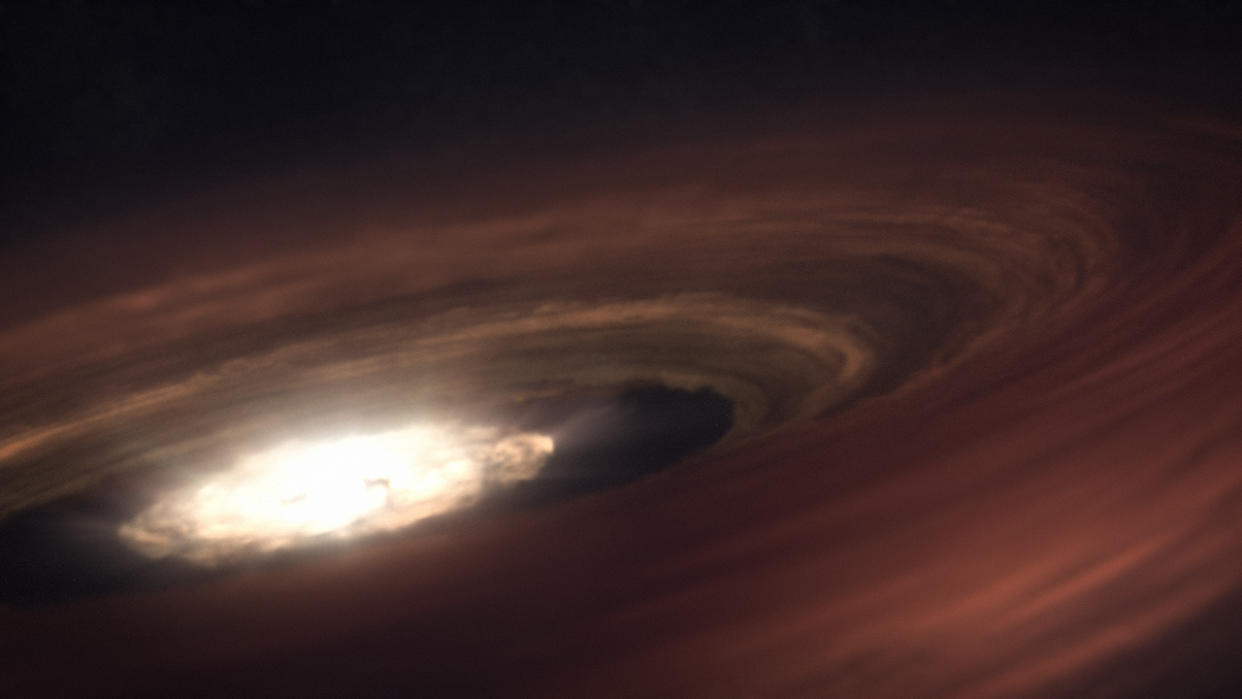James Webb Space Telescope makes 1st discovery of disappearing neon around newborn star

New observations from the James Webb Space Telescope suggest the amount of ionized neon gas present in dusty, planet-forming disks can tell us how quickly planets must form before the disk itself disappears.
Planets are believed to be born in disks of gas and dust that swirl around newborn stars. Astronomers have observed these disks before, but the entire planetary formation process takes hundreds of thousands — and even millions — of years to complete. That means we don't usually get to see the disks change on small timescales. Rather, the features just appear as snapshots frozen in time.
Now, however, the James Webb Space Telescope has observed one planet-forming disk changing quite substantially.
In 2008, a team led by Catherine Espaillat, who was then at the University of Michigan but is now at Boston University, used NASA’s Spitzer Space Telescope to detect an infrared emission line associated with doubly ionized neon ([Ne III]). The signal was coming from a planet-forming disk ringing the young star SZ Chamaeleontis (SZ Cha). An atom is "ionized" when one of its outer electrons is struck by a high-energy photon and knocked out of position; "doubly ionized" atoms involve the loss of two electrons from the impact of two photons.
Related: James Webb Space Telescope notches 1st rocky planet confirmation
When originally detected, the presence of [Ne III] in SZ Cha’s disk was considered a rarity among disks typically being bombarded by X-ray radiation from their young parent stars. Its existence actually implied that, instead of X-rays, lower-energy radiation in the form of extreme ultraviolet (EUV) must be the dominant type of radiation field in the SZ Cha system. This sort of radiation is thought to eat away at all the gas and dust in the planet-forming disk, thereby breaking molecules apart, but it's not thought to disintegrate disks as fast as X-rays do. X-rays can erode a planet-forming disk 100 times faster than ultraviolet light can.
Thus, the rate at which a disk "evaporates," and therefore the amount of time planets have to form within that disk before it disappears, depends upon the energy of radiation present.
However, when Espaillat and her team followed up on SZ Cha in 2023 with the JWST’s Mid-Infrared Instrument (MIRI), they found the doubly ionized neon had more or less vanished compared to the amount of singly ionized neon [Ne II]. This lack of doubly ionized neon implies that X-ray radiation, rather than ultraviolet, has indeed asserted itself as the dominant radiation field in the SZ Cha system.
Ultimately, this finding could have big repercussions in our understanding of how quickly planets must form before their disk dissipates.
"In computer models of developing systems, extreme ultraviolet radiation allows for one million more years of planet formation than if evaporation is predominantly caused by X-rays," said Boston University’s Thanawuth Thanathibodee in a statement.
As such, the abundance of doubly ionized neon could be considered a proxy for the amount of ultraviolet versus X-ray radiation impacting a planet-forming disk in a given moment. By measuring its abundance, astronomers can better constrain the timescale in which planets must form within a system before their birthing disk dissipates.

Complementary ground-based observations also found a piece of the puzzle: The CHIRON spectrometer on the SMARTS 1.5-meter telescope at the Cerro Tololo Inter-American Observatory measured "blueshifted" hydrogen-alpha emissions associated with the star in the SZ Cha system. Blueshift is a Doppler-like shift that indicates something in the distant universe is moving toward us — in this case, the hydrogen.
Scientists interpret the situation as a "stellar wind" of particles emanating from the star, headed closer to our corner of the cosmos.
The wind is thought to be dense enough to absorb ultraviolet light, but still allow X-rays through, permitting X-ray radiation to assert itself over the evolution of the star system. The fact that the doubly ionized neon was seen in 2008 but not fifteen years later, in 2023, suggests the wind might be variable and perhaps related to what kind of radiation permeates the star system's planet-forming disk.
Related Stories:
— Mars meteorite challenges leading theory of how the Red Planet formed
— James Webb Space Telescope spots intriguing carbon molecule in planet-forming disk
— James Webb Space Telescope spies water near center of planet-forming disk in cosmic 1st
Further studies are now being planned, not only with the JWST but also other observatories, covering different parts of the electromagnetic spectrum to try to get to the bottom of what is happening in the SZ Cha system. Hopefully, this will help scientists finally catch the stellar wind fluctuations. "We need to rethink, re-observe and gather more information," said Espaillat.
"We’ll be following the neon signs."
A paper about these findings was published on Wednesday (Nov. 15) in The Astrophysical Journal Letters.

